Content [show]
Rhododendron - planting and care in the suburbs
Rhododendron is a plant that is magnificent in its decorativeness and variety of species. Many gardeners believe that it is very difficult to grow it due to its exotic origin. In fact, if you follow fairly simple and straightforward rules, you can become the owner of a handsome man even in zones with a rather harsh climate, for example, in central Russia, namely in the Moscow region.
Origin, natural habitat Origin, natural habitat of rhododendron in the Ural mountains
Rhododendrons are the name of a genus that includes many species of deciduous, semi-evergreen and evergreen shrubs and trees.
To create the most favorable environment for development, it is worth remembering their habitat. The geography of distribution is quite wide. These amazing shrubs prefer places with high humidity - the coast of the seas, oceans, large rivers. You can meet them in semi-shaded areas or on the northern slopes of the mountains. The soil in the areas of growth has an acidic environment, rich in nutrients and moisture permeability.
Varieties for central Russia. Varieties for central Russia. Rhododendron Katevbinsky
For planting in the Moscow region, you need to choose only frost-resistant varieties. Here are some of them.
- Rhododendron, further r. Ledebour;
- R. Katevbinsky and its hybrids;
- R. Smirnov and hybrids;
- R. Short-fruited;
- R. Largest;
- R. Golden;
- R. Canadian;
- R. Schlippenbach;
- R. Vaseya;
- R. Pukkhansky;
- R. Adhesive;
- R. Pink.
Varieties for central Russia. Rhododendron pink
- R. Costerianum;
- R. Japanese;
- R. Kamchatka;
- R. yellow;
- R. alpine (dwarf).
Landing rules and place Landing place, rules for planting rhododendron
The most damaging natural factors for rhododendrons are wind and excess sun. Therefore, a protected place is chosen for planting, from the north or north-east side of the house or fence, which will be shaded from the scorching sun rays. Exots suffer not only from summer, but also from early spring sunlight.
Rhododendron buds, formed in August, often burn in the spring sun, which warms up enough at the end of February. As a result, the bush blooms only from the north side and where it was covered with snow.
To prevent this from happening, the rhododendron needs care. In early spring it is necessary to shade with shields on the south and west sides. This is done using shading material, which is securely attached to stakes driven into the ground, 1.5 times higher than the rhododendron. At the bottom and at the top, ventilation slots must be left. For shading, materials at hand are used: lutrasil (density 60g per m2) or spunbond, burlap (pulled with a double layer).
Shading of a young growth of rhododendron
Rhododendrons can be planted near other trees, remembering that shallow-rooted trees are bad neighbors. The battle for moisture and nutrients will end with the death of your pets. These include spruce, chestnut, linden, birch, maple. But the neighborhood of pine, oak, fruit trees is quite acceptable. The crowns of trees should not overshadow undersized shrubs.
As for the root ball of rhododendron, it is compact, located close to the surface, so they tolerate transplantation well, regardless of age.
The soil
Particular attention must be paid to the soil in which the bushes will be planted. As mentioned above, they are suitable for loose soil with an acidic environment, good removal of excess moisture. Drying out is also unacceptable. It is recommended to prepare such an earthen mixture: sour, red-colored high moor peat with pH = 4.5 - 5.5, loam and pine needles in proportions of 2: 3: 1. All components are important and necessary, because peat provides the necessary acidity and nutrition, loam does not allow the earth to dry out excessively, and pine needles make it lumpy and breathable.
The problem with rhododendron leaves with low soil acidity
Soil acidity is one of the most important conditions for good shrub growth. Before planting the rhododendron in the chosen place, samples of the substrate are taken to determine it. Then they are mixed, and one tbsp. put the spoon in a glass dish. Distilled water is also added here (fourfold). Everything is thoroughly mixed and left for a couple of hours, sometimes shaking the mixture. Then the indicator paper is moistened with it and the color of the paper is compared with the color of the scale. Thus, it is easy and simple to determine the pH at home.
If you find out that the acidity of the soil is insufficient, it can be increased in various ways:
- For example, by adding sphagnum peat from raised bogs (its pH is 3.6-4.0), heather land.
- You can also add chemicals such as sulfuric acid aluminum A12 (SO4) 3 (150 g per 1 m2 of soil), concentrated sulfuric acid (5 ml per 10 l of water). You just need to remember that it is necessary to add acid to water, and not vice versa. And this must be done very carefully. The mixture of rhododendrons is watered several times during the growing season. This will help maintain the pH of the soil.
- Physiologically acidic fertilizers such as potassium sulfate (Silvinit, Cainit, Kalimagnesia, Kalimag), superphosphate (Simple superphosphate, Double superphosphate, Phosphate flour), ammonium sulfate are also good ways to maintain soil pH.
Where is the best place to plant rhododendron
Growing and caring for rhododendron seedlings
To remove excess moisture, it is better to plant the rhododendron on hills, so that the root neck does not get wet due to melt water in spring. To prevent the hillock from spreading, you can overlay it with stones, which, moreover, will harmoniously fit into the composition.
For planting:
- they dig a hole about 60x60cm in size and 40cm deep;
- fill it with substrate components;
- mix thoroughly;
- tamp (this volume will require about 120 liters of ready-made earthen mixture, that is, 40 liters of peat, loam and needles);
- dig a hole to fit the size of the root ball and plant the plant in the ground (while making sure that the base of the root is not buried in the ground);
- the soil around is necessarily mulched with peat or needles, without filling its base.
Young specimens with a still undeveloped root system can be planted in a smaller pit - 40x40cm and 30cm deep. The volume of the substrate for it is 25 liters. As the roots grow, the hole can be increased in width by adding fresh earthen mixture.
It is better to plant a fragile tree in a protected, shaded corner of the garden, and only after 1-2 years plant it in a permanent place.
Caring for rhododendron Rhododendron is best planted in higher elevations
Rhododendrons do not require special care if planted according to all the rules. The main components are watering and timely feeding during the season.
Since these trees are moisture-loving, care must be taken that they do not suffer from a lack of moisture, as well as regular watering with rainwater. However, remember that excess water is also unacceptable, so do not overfill the rhododendron. It is better to water little by little, but more often so that the moisture has time to be absorbed.In August, watering is sharply reduced, or even stopped, so that the plant gradually begins to prepare for a state of dormancy. Care also includes removing weeds, but this can only be done by pulling them out, and the soil is not loosened.
Top dressing
Top dressing and fertilizers will allow you to grow both garden and indoor rhododendrons without any problems.
They have a very positive effect on the development of the plant. For top dressing, special mineral fertilizers, both liquid and granular (Ammophos, Nitrofoska, Diammofoska), are suitable. They are brought in according to the instructions from the beginning of May to the end of June. Further, no additional feeding is required until the next season.
In no case is ash used as fertilizer, as it alkalizes the soil, and the plants begin to get sick with chlorosis. Special acidifying agents, for example, colloidal or ground sulfur, will help to correct the situation. To change the pH by one unit, sulfur is added at the rate of 40 g per 1 square meter of land. But we must remember that its action will not be momentary. In order to see the result immediately, it is worth using a chelated fertilizer (for example, Zircon, Domotsvet, Tsitovit, Ferovit), which contains iron (for example, chelated iron).
Spruce needles help oxidize the soil and create ideal conditions for rhododendron
When caring for a rhododendron, spruce branches with needles will also be an excellent feeding. Fertilizer is done like this:
- cut the branches into pieces (1 cm long);
- fall asleep in a container, fill it with cold water;
- put on fire and boil for about 10 minutes;
- leave covered for three days;
- 1 liter of broth is diluted in 10 liters of water and the bushes are added;
- to reduce the acidity of the dressing, add 1 tablespoon of creamy lime to 10 liters of solution.
Mulching
Rhododendron maintenance includes annual mulching around the shrubs. The beds are covered with synthetic or organic material in order to protect the plants from poor environmental conditions and to enrich the soil.
They do it like this:
- it is advisable to lay mulch after rain;
- before this, it is recommended to loosen the soil surface so that it does not compact;
- a layer of mulch is from 4 to 9 centimeters;
- organic mulch is left in the garden for the whole winter.
Basic rules for the successful cultivation of rhododendrons in the Moscow region
Basic rules for the successful cultivation of rhododendrons in the Moscow region
- a deliberate choice of a variety, which must be necessarily winter-hardy, so that the plant overwinters without loss;
- the right choice of landing site: shaded in the summer from the midday sun and sheltered from the winds in the winter;
- optimal composition of the substrate (it is important to remember about acidity, the plant does not develop well on alkaline and slightly alkaline soils): high peat, leafy soil, needles in proportions of 2: 3: 1;
- regular watering (10-12 liters per tree two to three times a week);
- ensuring the removal of excess moisture from the soil by planting on small hills, since the shrub reacts poorly to excess moisture;
- compulsory annual mulching;
- exclude loosening of the soil directly near the bush, because the root system is located close to the surface. Therefore, it is advisable to remove weeds near the rhododendron bushes with your hands;
- a well-thought-out calendar of feeding with special fertilizers (for example, Gilea, Azalea).
Rhododendron - planting and care in the suburbs
Outcome
Even in an area with such a harsh climate as the Moscow region, magnificent rhododendrons can be grown without undue effort and effort. The main thing is to carefully follow all the rules of planting and care, as well as to know the best way to feed and how to mulch this exotic tree correctly.
 Hello dear friends!
Hello dear friends!
This article will be quite voluminous, since in it I collected as much information as possible about growing rhododendrons in my personal plot.
I will start, perhaps, with a brief description of this beautiful plant and tell you about its main species, which are best suited for the conditions of the middle lane.
So, rhododendron is one of the highly decorative woody plants. By the richness of its colors, shape, grace and splendor of flowering, it can easily compete with roses. Sometimes it is called that - "rose bush".
There are several main species of this plant of the heather family:
- Rhododendron evergreen decorative
- Rhododendron semi-evergreen decorative
- Rhododendron deciduous
Usually it is a shrub with a height of about 2 meters, less often - a small tree from 50 centimeters to 2 meters high.
During flowering, rhododendrons are unusually spectacular. Their flowers, bell-shaped or funnel-shaped, are collected in umbellate multi-flowered or corymbose inflorescences, which are located at the tips of the branches. In such a lush inflorescence there can be up to 20 - 25 flowers, and such a branch looks like a bouquet. And against the background of leathery glossy leaves, the flowers look just amazing.
Rhododendrons are considered by many to be thermophilic exotic plants that cannot be grown in our gardens. Based on my own experience in growing rhododendrons, I can tell you that this is not entirely true. There are some types of these plants that can be successfully grown in the middle lane, but what is there in the middle zone of Russia, even in the far north, the handsome rhododendron can become the first of the other brightly flowering shrubs on your site or in the garden.
I live in the middle Volga region and I can say that the following types of rhododendrons take root best in our zone: Canadian and Daurian. The same species are suitable for the conditions of central Russia. I'll tell you about them in brief:
Rhododendron Canadian is my favorite. Is a deciduous  undersized shrub. In height, it grows no higher than one meter. Its leaves are up to 6 centimeters long. On short branches there are up to 5 beautiful purple-pink flowers. The plant tolerates winter well and therefore can be successfully grown even in more northern regions.
undersized shrub. In height, it grows no higher than one meter. Its leaves are up to 6 centimeters long. On short branches there are up to 5 beautiful purple-pink flowers. The plant tolerates winter well and therefore can be successfully grown even in more northern regions.
Rhododendron Daursky is also delightful. He is more 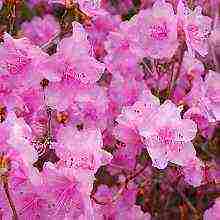 higher than the "Canadian" (up to 2 meters and even higher). Its branches are directed upwards. Leaves are leathery, small. For the winter, this species does not shed all the leaves, leaving some on the crown. When spring comes, the Daurian rhododendron blooms even before the leaves bloom. The flowers are large, funnel-shaped, up to 4 centimeters in size, purple-pink in color. This beauty can be observed for a month, but sometimes these rhododendrons bloom again in the fall. The plant tolerates winter very well, grows slowly, multiplies easily with green cuttings.
higher than the "Canadian" (up to 2 meters and even higher). Its branches are directed upwards. Leaves are leathery, small. For the winter, this species does not shed all the leaves, leaving some on the crown. When spring comes, the Daurian rhododendron blooms even before the leaves bloom. The flowers are large, funnel-shaped, up to 4 centimeters in size, purple-pink in color. This beauty can be observed for a month, but sometimes these rhododendrons bloom again in the fall. The plant tolerates winter very well, grows slowly, multiplies easily with green cuttings.
Until I forgot! For those who keep bees, I would not advise growing rhododendrons. But if you still want to combine these two interesting things, then during flowering, cover the rhododendrons during the day (up to 18 hours) with a light covering material. Their nectar is poisonous to bees.
It is best to plant rhododendrons in the light shade of trees, although, in principle, they grow well in open places.
Coniferous plants growing nearby create a favorable environment for rhododendrons, so the neighborhood with them is very successful. If you plant rhododendrons in groups, both monochromatic and differently colored, an amazing decorative effect is created. Good combinations of rhododendrons with Japanese quince, barberry, lilac. In general, here you can rely on your imagination. I think the effect will still be wonderful.
Growing rhododendrons and plant care
A distinctive feature of all rhododendrons is their slow growth, but it is compensated by the fact that one hundred plants are very durable and have the property of  maintain its decorative effect for decades. The soil for their successful growth must be acidic, with pH values of 4 - 5 (read about soil pH). Also, our soil should be loose, water and breathable, rich and nutritious. But in areas where water stagnates, rhododendrons will not grow, since stagnant water has a detrimental effect on them.Rhododendrons growing on peat soil feel great. They do not tolerate neutral and even more so soils with an alkaline environment, they do not like the presence of lime and chlorine in the soil.
maintain its decorative effect for decades. The soil for their successful growth must be acidic, with pH values of 4 - 5 (read about soil pH). Also, our soil should be loose, water and breathable, rich and nutritious. But in areas where water stagnates, rhododendrons will not grow, since stagnant water has a detrimental effect on them.Rhododendrons growing on peat soil feel great. They do not tolerate neutral and even more so soils with an alkaline environment, they do not like the presence of lime and chlorine in the soil.
Now a little about the root system of these plants: it is compact and shallow, so loosening must be done with great care, excluding digging up the near-stem circles. To protect the soil in the near-trunk circles from drying out, I mulch it with a layer of tree bark mixed with crushed peat. If possible, you can also use coniferous litter, which has an acidic reaction, which is what we actually need.
Planting and transplanting rhododendrons
 I would like to note right away that these plants tolerate planting and transplanting well. It is best to hold this event in the spring. Make the depth of the holes for planting at least 50 centimeters, but the width must be made more, about 70 - 80 centimeters. The soil mixture for planting must be specially prepared in advance. To do this, we need horse or sphang peat with low acidity, just do not add lime to it. With this peat, you need to mix coniferous compost, soil litter from those places where the pine grows. It is even better if in the pine forest you find a place where blueberries grow. In addition to these components, you can also add organic matter from dung or plant humus - 1 - 2 kilograms per pit and half a bucket of river sand. Of course, this composition can be simplified based on your capabilities, but, in my opinion, this composition of the soil mixture is ideal for planting rhododendrons.
I would like to note right away that these plants tolerate planting and transplanting well. It is best to hold this event in the spring. Make the depth of the holes for planting at least 50 centimeters, but the width must be made more, about 70 - 80 centimeters. The soil mixture for planting must be specially prepared in advance. To do this, we need horse or sphang peat with low acidity, just do not add lime to it. With this peat, you need to mix coniferous compost, soil litter from those places where the pine grows. It is even better if in the pine forest you find a place where blueberries grow. In addition to these components, you can also add organic matter from dung or plant humus - 1 - 2 kilograms per pit and half a bucket of river sand. Of course, this composition can be simplified based on your capabilities, but, in my opinion, this composition of the soil mixture is ideal for planting rhododendrons.
When planting, the root collar should be positioned slightly above ground level. The soil next to the root collar must be carefully compacted. Then it is necessary to water our plant abundantly and mulch the soil with well-crushed bark, or peat, or fallen pine needles. A layer of mulch should be made about 5 - 6 centimeters. After 1 - 2 years, in the spring, you need to add a bucket of compost and peat or humus and peat to the soil of the trunk circle, filling this bedding to a shallow depth. Oh, yes, you must first add dry mineral fertilizers to the bedding: potassium sulfate, superphosphate, ammonium sulfate. All these components should be taken in 1 tablespoon.
In open field conditions, it is quite difficult to constantly maintain an acidic environment, but by following these steps, you can achieve this.
From the site of the required area, you need to select land to a depth of 40 centimeters. After that, pour a drainage layer of large pebbles about 15 centimeters high on the bottom. Instead of pebbles, you can take broken brick or rubble. Next, you need to pour acidic soil on top of our drainage, consisting of a mixture of pine needles, rotted needles, crushed bark and peat. Then you need to scatter mineral fertilizers on top: one tablespoon of potassium sulfate, urea or ammonium sulfate, and Agricola for flowering plants. Now all this must be mixed, level the garden bed, water and plant the plants. With this method, the roots of rhododendrons are constantly in an acidic environment, and our favorite plants grow successfully and delight us with their flowering.
Top dressing
Top dressing No. 1 is carried out in early May: one tablespoon of potassium sulfate and urea per ten liters of water. Consumption - three liters for each bush.
Top dressing No. 2 is carried out at the end of May: one tablespoon of potassium sulfate and "agriculture for flowering plants" per ten liters of water. Consumption - four to five liters per bush.
Top dressing No. 3 is carried out after the flowering of rhododendrons: one tablespoon of superphosphate and potassium sulfate per ten liters of water. Consumption - five liters for each bush.
How to propagate rhododendrons by layering
Although the best way to propagate these plants is by cuttings, which I will discuss below, the method of propagation by cuttings also has a place to be. Let's talk a little about him.
On the branch that is closest to the soil surface, an incision should be made without splitting the branch to the end. So that our incision does not close, you need to insert into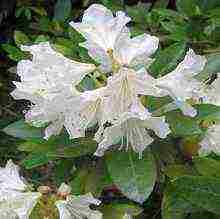 him some small pebble or small sliver. Now this branch must be bent to the ground by digging a small groove under the branch. We lower a part of the branch in the place of the cut into the groove, fix it with a wire or wooden hairpin, fill the groove with a branch with a loose soil mixture, but it is better to fill it with peat.
him some small pebble or small sliver. Now this branch must be bent to the ground by digging a small groove under the branch. We lower a part of the branch in the place of the cut into the groove, fix it with a wire or wooden hairpin, fill the groove with a branch with a loose soil mixture, but it is better to fill it with peat.
Closer to autumn, small roots should form in the cut. In the spring of the following year, the rooted seedling can be carefully separated from the main (mother) plant.
Now about how to cover the layers for the winter. It is better to do this with dry leaves and spruce branches. In the early years, these plants grow very, very slowly. They begin to bloom in the fifth or sixth year. In order for immature young rhododendrons to grow better and form shoots, fading inflorescences should be regularly removed.
Well, now, as I promised above, I will tell you about how to propagate rhododendrons by cuttings.
The best time for cuttings is June - July.
- With a thin sharp knife, cut off a stalk about 10 - 15 centimeters long.
- We remove the lower leaves.
- We place the cutting in a solution of "Heteroauxin" - a growth stimulator. For 10 liters, you need to take 2 tablets of the drug. The temperature of the solution should be 20 - 22 degrees. Soaking time is 20 hours.
- Next, you need to plant our cutting in a special soil substrate. On sale you can find a ready-made substrate called "Rhododendron land". If it is not possible to purchase such a substrate, then we prepare the "acidic" soil substrate ourselves, consisting of a mixture of coniferous soil, sand and peat.
- From above you need to cover the cuttings with foil or glass. It is necessary to constantly moisten the substrate so that there is a special humid microclimate under the glass that promotes the fastest root formation. The temperature should also be constant, at least 25 - 27 degrees.
A well-developed root system usually develops after two to three months.
Recommended varieties:
Pink: Renata, Mark, Panenka
White: Alena, Jackson
Gold and yellow: "Norm"
Purple and lilac: "Bourzault", "Sapphire", "Blue Peet"
Reds: "Scarlet", "Elizabeth", "Albrechta"
That's all about growing rhododendrons in the garden. I hope this article will be useful for you and will help you grow beautiful plants. I will gladly accept your comments, feedback, and additions. Do not forget to subscribe to the news of the site "Private House Garden and Vegetable Garden".
See you, friends!

- Type: heather
- Flowering Period: April, May, June
- Height: 0.3-1.5m
- Color: white, pink, purple, red, yellow, purple
- Perennial
- Hibernates
- Shady
- Moisture-loving
It is difficult to imagine a suburban area without the usual permanent residents - peonies, roses, poppies, dahlias, decorating flower beds and flower beds with their lush hats throughout the summer. However, sometimes in the dachas of the middle lane and southern regions you can find an unusual beautiful shrub that resembles a rose. This is a rhododendron, a rather capricious heat-loving plant. It is not easy to find an approach to it, but the cultivation and care of rhododendrons over time for some lovers of rare plants develops into a hobby - these magnificent flowers are so beautiful and exquisite.
- An exotic guest at your dacha
- Planting rhododendrons: time, soil, lighting
- The nuances of flower care
- Watering mode and features
- When is the best time to prune a plant
- Protection from pests and diseases
- Top dressing and choice of fertilizers
- Breeding methods - which one to choose
- The most popular summer cottages
An exotic guest at your dacha
Like most of the lushly flowering crops, rhododendron is rarely found in the Russian wild, but grows exclusively under the supervision of gardeners.
Many species take root and feel great only in southern latitudes, so they can be safely grown in the Crimea, Krasnodar Territory or Stavropol Territory.However, some varieties, for example, Daursky or Canadian, develop well in temperate climates, so if you live in the Moscow region, in the Urals or even in the Siberian outback, rhododendron can also decorate your summer cottage with its magnificent flowering.

Literally translated from Latin, "rhododendron" means "rose tree" - and indeed, in its appearance, the plant is very much like a rose, although it does not belong to rosaceous, but to heather
You are certainly familiar with one of the types of rhododendron - this is the well-known home azalea, which often adorns the windowsills of city apartments. It is distinguished by lush flowering and a variety of shades.
It is impossible to imagine how the relatives of this small plant can reach 25-30 meters in height, although in fact in the Himalayas, Japan, North America, some species grow to such gigantic sizes.
There are also low rhododendrons, which are separate bushes or creeping shrubs that feel comfortable at the foot of the mountains and in coastal marine areas.

Mountain varieties are small in size and are ideal for organizing alpine slides. For example, the Kamchatka rhododendron is unpretentious, grows only up to 35-40 cm in height and has a bright pink tint.
Among annuals and perennials (and there are about 3 thousand species in total), you can choose a variety whose characteristics are suitable for growing in a certain region.
If you need a special shade - reddish, purple, white or yellow - this will not be a problem either, since the color palette of crops is almost limitless. Flowering culture begins in early spring and continues throughout the warm period.
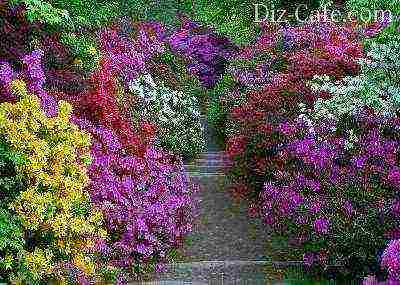
Thanks to its luxurious color palette, garden azalea can be combined with various types of flowering crops and used for growing in columbariums, rock gardens, multi-tiered flower beds
Planting rhododendrons: time, soil, lighting
Following general recommendations, planting can be carried out both in autumn and in spring, that is, during a convenient growing season for you, excluding flowering time and a short period after flowering - about 10 days. However, experienced gardeners still insist on a spring planting, which continues, depending on the region, from April to May 10-15.
Varieties planted earlier than this period are already covered with a dense color by the May holidays - against the background of barely hatching foliage and fresh grassy greens, they look very impressive.

One of the early flowering rhododendrons is P.J. Mezitt is a lush plant with pink and lilac buds. The beginning of its flowering occurs in the last decade of April - early May.
It is important to choose the right landing site, since in the bright sun the plant will feel uncomfortable, and in a completely darkened place it will not give a lush flowering.
It is best to break a flowerbed with rhododendrons on the north side of the building, in a semi-shaded area, so that at noon, when the sun's rays reach maximum strength, the plant is completely closed from them.

A shade barrier for a flower garden can be not only the walls of a building, but also a fence or tall trees. Rhododendron gets along well with trees, the roots of which go deep into the soil and do not interfere with the development of the plant - oaks, larch, spruce, as well as fruit trees - pears or apple trees
Flowers absolutely cannot stand alkaline or neutral soil - it must be acidic, rich in humus, well aerated, without lime admixtures. One of the best growing materials is a mixture of peat and clay.
Rhododendron is planted in the following order:
- dig holes, shallow (35-40 cm) and wide enough (55-60 cm);
- the lower part is drained with a sandy-pebble layer (10-15 cm);
- they are covered with a mixture of loam and peat (high moor or sphagnum, with low acidity), while peat should be about 2 times more;
- lightly tamp the soil inside the pit and make a hole in it the size of an earthen lump of the seedling;
- the roots of the seedling are lowered into the hole and covered with soil mixture to the very root collar, which, as a result, should be on the same level with the soil surface;
- water the plant abundantly if the soil is dry;
- produce mulching (to a depth of 5-7 cm), for which peat, moss, rotted needles, leaves and crushed oak bark are suitable.
In order for the plant to better take root in a new place, soak the roots thoroughly with water before planting - lower the seedlings in a container with water until air bubbles stop appearing on the surface.
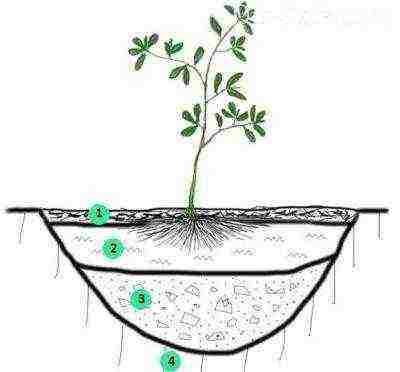
An approximate scheme for planting a rhododendron: 1 - garden soil; 2 - drainage; 3 - soil mixture of peat, clay or loam; 4 - a layer of pine needles
There is one more trick to promote better root development. Cut off the most lush buds of a flowering plant - this way the seedling will spend more energy on rooting. Planting and further caring for rhododendrons are important steps, following which you will achieve amazing results.
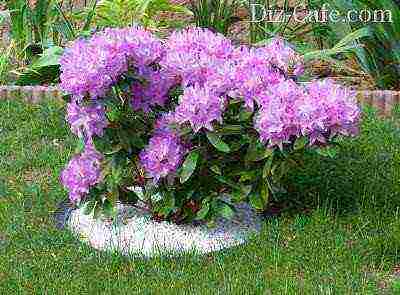
It is better to start decorating a planted bush in a couple of weeks - after it is completely rooted. You can give the plant a certain shape, and decorate the base depending on the style of landscape design of your site
The nuances of flower care
The norms for proper care of flowering shrubs do not differ from generally accepted standards: it is necessary to observe the watering regime, weed and prune on time, feed the plant with suitable minerals and make sure that pests do not start.
There are also subtleties, for example, a careful approach when loosening. The roots of the plant are very close to the surface, so you need to loosen the soil very carefully, and you should not dig it up at all. When removing weeds, in no case use a hoe or a garden knife, you can only act by hand.
Watering mode and features
The ratio of rhododendron to moisture is very interesting. On the one hand, it absolutely does not tolerate waterlogging, on the other hand, it requires constant spraying and irrigation with specially prepared water.
Even when choosing a site for planting, check whether the groundwater does not come close to the surface. The fact is that with a large amount of moisture in the soil, the roots will simply "choke" and the plant will die. That is why a drainage layer is needed to drain excess water.
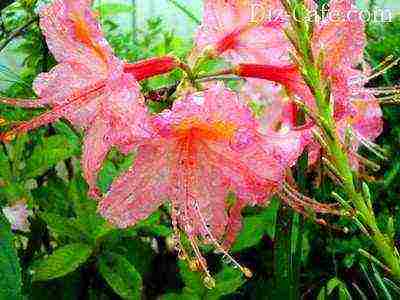
It is especially important to observe the irrigation regime and atmospheric irrigation during the period of bud development and flowering - the better the watering, the brighter and more magnificent the inflorescences will be
Watering is carried out regularly, pre-acidifying the water - for this, 12-20 hours before watering, 2-3 handfuls of sphagnum peat are placed in a container with water. It is better not to use tap water, as a last resort, it must be defended. The ideal option is rain collection. The regularity of watering depends on the state of the plant: as soon as the leaves have lost their glossy shine and changed their turgor, it is time to water.
When is the best time to prune a plant
The concept of pruning is very conditional. Usually, the plant develops evenly and forms a profusely flowering bush of the correct shape, so lovers of lush flower beds do not need to prune. But sometimes you need to thin out the shrub, make it a little lower, or just rejuvenate it.
Pruning is carried out in early spring, until the sap flow has begun. They choose strong, thick branches with a diameter of 3-4 cm, carefully cut off the ends with garden shears and process the cuts with specially prepared garden pitch or resin. In about a month, the renewal process will start, which continues throughout the year - new shoots will hatch and dormant buds will begin to develop.
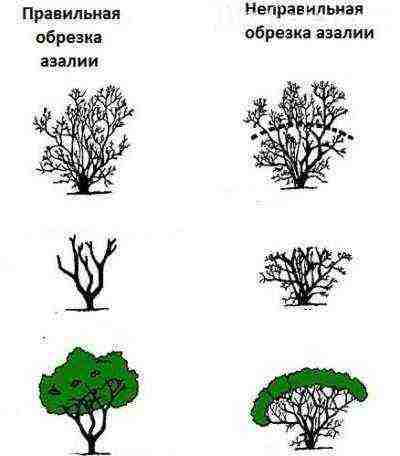
Pruning frozen or old bushes requires special skill: thick branches should be cut at a distance of 35-40 cm from the ground alternately within 2 years: some this year, the second - next
Rhododendrons are characterized by uneven flowering. If this year they delighted you with a particularly exuberant color, expect more modest results next year.To prevent this from happening, remove wilted buds immediately after flowering, and then the plant will have enough strength to gain as many buds as possible in the second year.
Protection from pests and diseases
Branching bushes with dense foliage and many buds are a great place to live for insects, half of which can destroy the beauty you have grown within a couple of weeks, so a number of measures must be taken to protect the shrub.
Thick trunks and branches are a favorite place for mollusks. Slugs and snails are collected by hand. Beware of scale insects, bedbugs, spider mites, rhododendron flies, mealy worms. Treat the stems and branches with 8% Tiram fungicide, Karbofos helps well.
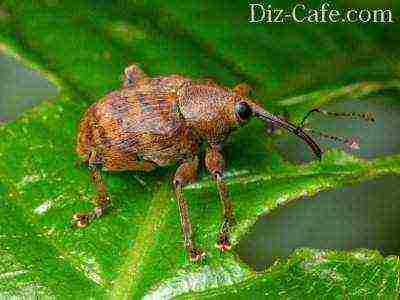
It is more difficult to remove bedbugs, ticks, and especially the weevil, for which diazonin is used to get rid of. Remember, in order to say goodbye to a harmful guest forever, it is necessary to process not only the plant itself, but also the top layer of soil around it
Along with insect pests, rhododendrons are threatened by diseases of the fungal type - rust, chlorosis, spotting. The reason lies in insufficient aeration and non-compliance with the irrigation regime. Yellowness resulting from chlorosis is treated with an iron chelate solution. If rot appears, the affected shoots should be cut off completely. For prevention, seasonal treatment with Bordeaux liquid is carried out in late autumn or early April.
Top dressing and choice of fertilizers
It is necessary to start feeding rhododendrons from planting and throughout the entire flowering period. To preserve an acidic environment important for culture, superphosphate, potassium sulfate, potassium nitrate, magnesium sulfate or calcium, ammonium are used, but in a minimum concentration.
Early spring top dressing is made up of fertilizers containing nitrogen (for 1 cubic meter of liquid 40-50 g of magnesium sulfate or ammonium), it is also relevant in the period after flowering. In July, the fertilizer dose should be reduced to 20 g.

The ideal feed for rhododendrons is a liquid solution of natural fertilizers such as horn meal or cow dung. Overripe manure is diluted with water (1 part of fertilizer per 15 parts of water), infused for 3-4 days and used during watering
After 1-2 years after planting, it is necessary to renew the topsoil. To do this, peat is mixed in equal parts with humus or compost and sprinkled around the roots. Along with natural ingredients, superphosphate, potassium sulfate or ammonium are added to the bedding (dry matter - 1 tbsp. Spoon). Agricola can be used as a dry powder for flowering garden plants. Remember to fertilize only carefully watered shrubs.
Breeding methods - which one to choose
Consider the three most successful ways to reproduce rhododendron in the garden:
- seeds;
- cuttings;
- layering.
Growing plants from seeds is a long and laborious task. Dry, healthy seeds are sown in pots or boxes of damp peat, a little sand is added, covered with glass caps and placed in a well-lit place. Within a month, it is necessary to moisten the soil and remove condensation from the glass.

The seedlings that appear after 4 weeks are planted in a greenhouse with a cool climate according to the 2 x 3 cm scheme.The seedlings will grow for a very long time, and only after 6-7 years you will see the first flowering
Reproduction by cuttings is also not tolerated by all gardeners. It is necessary to take half-woody shoots and cut several cuttings about 7-8 cm long from them.
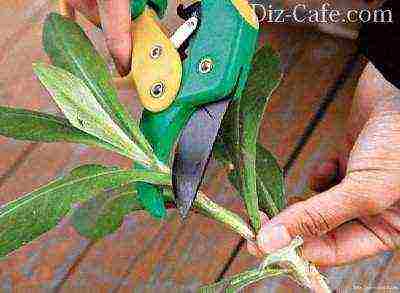
The leaves are removed from the bottom, and the treated end is placed in a container with heteroauxin - a growth stimulator, where it is kept for 12-15 hours
Then they are placed in peat soil and covered, as is the case with seeds. Depending on the variety, the cuttings will take root in 2-4 months, after which they are transplanted into boxes with peat-coniferous soil and taken out to a cool greenhouse. The optimum temperature is 10 ° C.They are planted in spring along with other flowers, right in boxes, and only after a couple of years they can be transplanted to the main place of growth.
The most convenient breeding option is pinning layers. A flexible lower shoot is taken, a groove 12-15 cm deep is pulled out near it, and the shoot is placed in this groove.
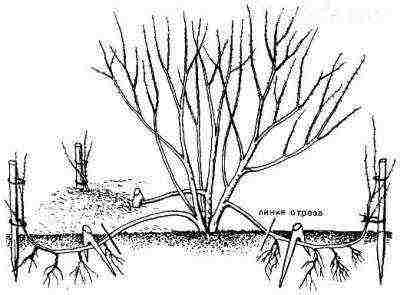
So that it does not rise, the middle part of the stem is pinned, and sprinkled with peat on top. The upper part must be brought out and tied to a support - a wooden peg stuck into the ground
The layering is looked after in the same way as the entire bush - watered, sprayed. When it takes root (in late autumn or spring), it is carefully separated, dug up and transplanted to a place of permanent growth. This method is especially good for the propagation of deciduous rhododendrons.
The most popular summer cottages
In a coniferous garden, a 2-3-meter Daurian rhododendron will live well. It is distinguished by abundant flowering of buds, reaching a diameter of 4 cm.
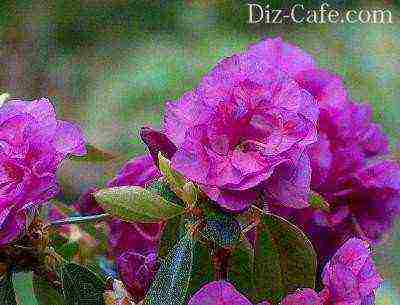
If the warm season drags on, then the Daursky variety will surely delight you with repeated autumn flowering, and next spring the winter-hardy plant will bloom as usual
Rhododendron Adams is an oriental guest accustomed to rocky mountain soils.
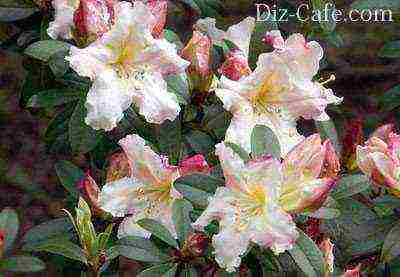
A beautiful plant with pale pink flowers grows up to one and a half meters in height. In our country, it is rare, and in Buryatia it is listed in the Red Book
The low, creeping Caucasian rhododendron is a real find for rock gardens.

The petals of the inflorescences of the Caucasian rhododendron are distinguished by an unusual pale yellow or cream shade, which will remarkably dilute the more saturated, juicy colors of other varieties
The Japanese rhododendron is a magnificent deciduous cultivar with flamingo-colored buds.
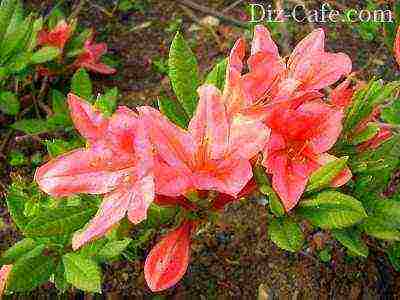
Japanese rhododendrons with delightful flowers and picturesque foliage that turns red in the fall are unpretentious, winter-hardy and reproduce well in any way - an excellent option for growing in central Russia
And finally - a short video on how to achieve lush flowering of rhododendrons.
Conditions
Garden-grown rhododendrons are deciduous or evergreen shrubs that are completely blooming in spring.
| Rhododendron- the largest, as well as the most famous and popular genus of the extensive Heather family. Moreover, it is very ancient. The ancestors of today's beauties appeared on earth about 50 million years ago. Currently, there are more than 1000 species of rhododendrons, on the basis of which about 12,000 varieties with a wide variety of qualities have been obtained. |
However, the splendor and splendor of flowering did them a disservice: a Russian gardener, looking at a splendid picture in a magazine, often thinks: "This is not for us ... Somewhere in the south - yes, but this will not winter here"... However, everything is not so - it will overwinter and bloom will be no worse than in the picture. You just need to provide the plant with the appropriate conditions in the garden and choose a winter-hardy variety.
Before going to the store for rhododendrons, you need to assess the capabilities of your site and decide whether it is suitable for planting them. These shrubs require good drainagecompletely eliminating stagnant water, andwind protection, especially in winter and spring. Increased humidity air andslight shading... The shade on the southern side of the plantings is especially important in early spring: at this time, the sun dries up the leaves of evergreen varieties, they "burn". Deciduous rhododendrons are more tolerant of this factor, but flower buds and tops of the shoots can also be damaged.
| As the most general recommendations for improving the soil, you can offer the following:
- on light and medium loams, add red high-moor peat (do not lime!), Rotten coniferous litter; - in sandy soil - soil with clay particles, red high-moor peat, compost, coniferous litter; - the usual light garden soil must be acidified with the addition of high-moor peat and needles. |
The soil should be loose, moderately nutritious, with an acidic reaction. In its original state, the soil at the summer cottage is rarely suitable for rhododendrons, except that your garden is in a pine forest. As a rule, the gardener knows what exactly needs to be done with the soil at the planting sites so that it becomes loose and “breathable”.
In general, it is desirable to achieve such a soil structure that the gardening tool enters into it without effort.
And the last - on the site there should be the possibility of regular watering of plants.
Choice
If all of the above is already in your garden or it is in your power to correct the local conditions correctly, then you can think about choosing a species and variety. First of all, the question arises, which rhododendron to prefer: evergreen or deciduous? For areas with a lack of shade, it is better to start with deciduous, but if there are enough shady places, then it is worth trying to plant evergreens too. But certainly winter-hardy!
| The rhododendron variety is considered winter-hardy, in which flower buds (the most vulnerable spot) tolerate prolonged frosts without damage. And they, as you know, are different - somewhere the typical winter temperature rarely drops below –15 ° С, and somewhere it is stable –30 ° С and more. Accordingly, you should select plants for your garden. |
In central Russia, a number of species rhododendrons, the flowering of which is in no way inferior to varietal beauties. At the same time, they are highly resistant to various adverse conditions, therefore they will be welcome guests in every garden. These are such deciduous rhododendrons as yellow, Kamchatka, Canadian, soft, pink (or prinophyllum), Schlippenbach, Japanese, and evergreen species: Caucasian, Katevbinsky, largest, Ledebura, dense, Smirnova and some others. They can often be found on sale at exhibitions and fairs.
However, most often, when going shopping, you have to choose fromvarietal rhododendrons... The pedigree of most varieties is very confusing, but usually they are combined into groups of hybrids, each of which had its own species "founder". This helps you figure out if a particular strain is right for your garden conditions. And to make this difficult task easier for you, we have compiled an approximate list of hybrid rhododendrons with which you can go to the store without fear of making a mistake and without memorizing names that are unusual for our ear.
Deciduous
Among the most winter-hardy deciduous varieties (for winters with frosts of –30 ° C and below) are plants from the Northern Lights series. These are hybrids of the rhododendron prinophyllum. They do not have the largest flowers, but docile nature, good growth rate, dense bushes and abundant flowering. All of them reach a height of 130–150 cm in adulthood. Rosy Lights have pink flowers, Lilac Lights have purple flowers, and Mandarin Lights have orange flowers. White Lights blooms white, while Golden Lights and Lemon Lights bloom in different shades of yellow.
Many (although not all!) Varieties from the KnapHill-Exbury group (hybrids based on soft rhododendron) and some plants from the Rustica group: Freya, Narcissiflor and Tasso differ in absolute resistance to cold in central Russia and, in particular, in the Moscow region.
|
Rhododendrons of the KnapHill-Exbury group (frost resistance -30 ° С) |
|
|
Name |
Flower color |
|
Anneke |
light yellow, very large |
|
Feuerwerk |
red with orange tint |
|
Gibraltar |
orange, slightly tinted yellow, turn red towards the end of flowering |
|
Juanita |
dark pink, with a large golden yellow spot on the upper petal |
|
Klondyke |
golden yellow, very intense color, large |
|
Nabucco |
dark red, almost black buds |
|
Persil |
snow white with contrasting yellow spots |
|
Silver slipper |
creamy white, with a delicate light yellow pattern |
Of interest are the varieties of Japanese rhododendron:
- Dr. M. Osthoek: flowers are dark salmon red with a light salmon spot;
- Directeur moerlands: flowers are golden yellow, inside the flower is colored more intensely, with an olive-green spot;
- Dr. Reihenbach: flowers are light salmon-orange;
- Hugh koster: salmon-orange flowers with a red throat and a brown spot.
Evergreen
Of the evergreen varietal rhododendrons for growing in central Russia, plants from the group Katevbin hybrids (Catawbiense, or Catawbiense-Hybridum), named after its ancestor - p. katevbinsky, which was crossed with other winter-hardy rhododendrons in central Russia. Some of them are largely frost-resistant, grow very well under our conditions and reach 3-4 m in height and up to 1.5 m in crown diameter.
A relatively new group of winter-hardy evergreen rhododendrons -Marjatta hybrid , including plants of Finnish selection. It is named after its author - the famous Finnish breeder Marjatta Uosukainen. These varieties are mostly bred on the basis of rhododendron short-fruited and are distinguished by light-colored flowers of pale pink or white tones. All of them are characterized by high frost resistance and are suitable for growing in conditions with winter temperatures from –29 ° to –34 ° С).
|
Katevbin hybrids |
||
|
Name |
Frost resistance |
Flower color |
|
Album Elegans |
-29 ° C |
white with greenish-yellow dots on the upper petal |
|
Catawbiense Grandiflorum |
-30 ° С |
lilac ‑ purple, with brown ‑ red specks |
|
Purpureum Elegans |
-30 ° С |
purple with a violet-lavender tint around the edge of the petals |
|
Roseum elegans |
-32 ° C |
bright pink, inside with a delicate bronze pattern |
|
Calsap |
-32 ° C |
white, slightly pinkish at the beginning of flowering. On the inside there is a large, clear brown spot |
|
Nova Zembla |
-29 ° C |
ruby red with a darker center |
|
Purpureum Grandiflorum |
-30 ° С |
purple, lighter inside than outside, with a golden brown spot on the upper petal |
|
Rasputin |
-26 ° C |
violet-blue, inside with a large dark spot |
Hardy enough in central Russia and the so-calledP. J.M.-hybridsobtained on the basis of Carolinian rhododendron. They are also suitable for cultivation in our area, where winter temperatures are from –29 to –34 °. More often than others, cultivars can be found in our garden centers. Elite (P. J. M. Elite).
As for the very often sold in our garden centersYakushima rhododendron hybrids , then they do not have good winter hardiness and, as a rule, freeze over already at minus 18–20 °. But among them there are also several varieties that can grow in the middle lane:Falling snow (-28 ° С), Fantastica (-25 ° С), Lumina (-28 ° С), Schneebuket (–26 ° C).
In the last decade, low-growing varieties have become very popular, they look great in rock gardens or low curbs, from the group of so-called kurum azaleas or varieties derived fromrhododendron blunt .
In the Moscow region and in central Russia, they feel good, and thanks to the presence of a high and stable snow cover, they also winter wonderfully under it. But one feature can negate all efforts to grow this group of rhododendrons: snowfall for 10-15 days is often preceded by frosts of -25-28 ° on bare ground. As a result, many plants die, including stunted rhododendrons. Therefore, this group requires increased attention to itself in order to protect it from adverse effects, although in general its representatives are distinguished by good winter hardiness and are able to withstand frosts down to -32 °. The most common varieties on sale areKermesina, Maruschka, Saschiko and etc.
Finnish varieties |
||
|
Name |
Frost resistance |
Flower color |
|
Haaga |
-36 ° C |
dark pink with a red-orange spot on the upper petal |
|
Helsinki University |
–39–40 ° С |
light pink, lighter inside, with a greenish-orange pattern on the upper petal |
|
R. M. A. Tigerstedt '(Peter Tigerstedt) |
-36 ° C |
white with reddish-brown spots in the center |
|
Mikkeli |
–37–40 ° С |
white with a pink glow and a light green spot on the petal, by the end of flowering almost white with a slight green tint. |
|
Rekka |
-34 ° C |
light pink with a brown spot |
|
Elviira |
-34 ° C |
purplish red |
|
Hellikki |
-34 ° C |
purplish red |
|
Pohjolan Tytar syn. Pohjola's Daughter |
-34 ° C |
when blooming - salmon, by the end of flowering brighten, almost white with green or brown spots on the upper petal. |
One of the rhododendrons of hybrid origin - Cunningham's White - I would like to note separately. This variety was bred by the Englishman Cunningham back in 1850. A dense, dense, domed bush reaches 1.5 m in height with a much greater width. Its flowers are very spectacular: pinkish in buds, then white with greenish-yellow spots. It blooms in April – May, and often repeatedly (as a rule, when the summer is warm and humid). The variety is winter-hardy and unpretentious and grows relatively well even on alkaline soils.
How to grow
Landing
It is worth paying special attention to the correct planting of the rhododendron. It would seem that they chose a suitable place, prepared the soil, joyfully brought a pot with a winter-hardy variety from the garden variety, easily took it out of the container and planted it. It's not difficult at all. But the possible danger lies in the container content of rhododendron. The fact is that the roots of the plant, in contact with the walls of the pot, begin to die off. If the bush is in the container for a long time, then the layer of dead roots turns out to be quite dense. When you plant such a bush, it turns out that its living roots still end up as if in a container, only not in a plastic one, but formed from a dense "felt" of dead roots. The root system has nowhere to develop, young roots cannot make their way to the soil and the rhododendron is simply starving. In this case, the layer of dead roots must be carefully removed or, in extreme cases, several transverse cuts in the root ball must be made.
| The top of the root ball from the container should be level with the soil surface at the planting site. Do not deepen the rhododendron root collar! If this rule is violated, the plants stop blooming, and eventually die. |
The size and depth of the planting pit are determined by the soil conditions and the water regime of the site. Under normal conditions, its width is 60–70 cm, depth is 30–40 cm. On heavy clay soils, the pit should be shallower (15–20 cm), but much wider (1.0–1.2 m). It is filled with high-moor peat or a previously prepared soil mixture. It is very important that the substrate is acidic - with a pH of 3.5–5.0. As such a mixture, the following options can be recommended:
- sour peat, coniferous and leafy soil, river sand (3: 1: 2: 1);
- sour peat, sawdust, sand (2: 1: 1);
- peat, fallen needles, sawdust, sand (2: 1: 1: 1), etc.
It is desirable to add a complete mineral fertilizer to the soil mixture at the rate of 150-200 g per 1 m³, as well as 40-60 g of sulfur. A small roller of earth is formed around the planting site and water is gradually poured until the earth is completely saturated with moisture. After 1-2 weeks, the soil is leveled, but a small depression is left so that the water is retained during further watering.
Care
The principles of the generally uncomplicated care of rhododendrons are easy to understand if you know the features of their root system. It is really not quite common: plants have a large number of thin roots, located compactly and densely, close to the soil surface. The coma is wider than deep. There are no core, deep-rooted roots. For example, a 15-year-old bush of a medium-sized variety may have a root ball diameter of 80 cm and a depth of 35 cm. Mulch will help protect such a root system from drying out, overheating and a sharp change in temperature in snowless frosts. therefore mulching is a really necessary grooming technique... Shredded bark or cones, needles, coniferous or light garden compost, composted small chips of coniferous species, etc. are suitable as coverings.
| To acidify water, it is very good to use a dilute sulfuric acid electrolyte for acid batteries. At the same time, there is practically no risk of getting burns, and 10–20 ml per bucket of water reduces the pH from 7 to 4–5 units.In addition, by using the electrolyte, you add sulfur, a vital mineral nutrient for heathers. |
Watering rate usually 1–1.5 buckets two to three times a week for an adult plant. Young seedlings are watered more often, but not more than 0.5 buckets per 1 bush. During flowering, plants need more frequent watering. If the weather is dry in autumn, then the rhododendrons should also be watered abundantly - this contributes to a better overwintering. And in dry and hot weather, the bushes are sprayed with water.
The pH of the water used for irrigation is of great importance. It should be no more than 4–5 units, otherwise the soil is alkalizing and the rhododendrons begin to hurt. To avoid this, the water is acidified before watering. You can use concentrated sulfuric acid (1 ml per bucket of water), or oxalic, citric or other organic acids (3-4 g per bucket of water). It is permissible to use table vinegar - about ½ cup per bucket of water.
A useful event when growing rhododendrons - removal of faded inflorescences... This prevents the formation of seeds, but it allows the plant to use the nutrients to set flower buds for flowering next year, as well as for shoot growth. At a young age, the removal of inflorescences causes the formation of new branches and better growth of the bush in width and height. Additional branching can also be achieved by removing the vegetative buds.
| Pruning rhododendrons is optional, but possible to form a bush. Thus, they achieve a spherical or standard shape. Pruning is carried out immediately after flowering. In early summer, remove excess root suckers and long shoots. Dry and damaged branches are cut regularly. Fast-growing varieties and forms tolerate pruning better, but for most it retards growth and the first flowering. It is also important to protect plants from diseases and pests in time. |
Shelter
Late spring and early autumn frosts are not dangerous for rhododendrons. Most varieties during the period of active vegetation and flowering are able to withstand a drop in temperature down to –7 ° С.
But the question "to cover or not to cover the planting for the winter" is decided individually for each site. If a winter-hardy variety is chosen and it is planted in a suitable place, protected from the wind and early spring sun, then only snow will be the best and completely sufficient shelter. If the location is not ideal, you will have to install shade and windshields.
A separate question is how to protect the bushes of evergreen rhododendrons from falling apart with snow. There are two ways: worry about it and take measures to protect it, or let the plant "float freely", leaving it to solve the problem on its own. In the first case, you will have to install snow clearing structures above the bush or tie the branches with elastic material. You can build a frame around the plant and stretch a dense mesh or something like that over it. As a result, the bush will retain the shape characteristic of the variety, but you will be doomed annually, as it grows, to adjust the size of protective structures. In the second case, if you do nothing, you will get a free-form bush and with some frequency, after winters with especially heavy snow, the loss of a certain number of shoots broken by snow.
Location
Any variety can be planted as a single bush on the lawn or under the canopy of trees. They will look great in compositions on alpine slides, in "Japanese gardens", and even in hedges. They can be used to create beautiful low to medium height curbs. And of course, these plants will become the main decoration of the heather garden.
Two-faced Janus
What is the difference between rhododendrons and azaleas?
N.M. Strashko, Tarusa
The candidate of biological sciences Tatyana Kurlovich answers:
There is absolutely no difference.Initially, azaleas were classified in a separate genus, and later - in a special section. It was believed that rhododendrons have ten stamens, and azaleas have five. But both of them often have deviations from these norms. In addition, there were a number of other signs that do not say anything to an ordinary gardener. In later classifications, this section got rid of, and its representatives were scattered among other departments, and none of them received the name "Azalea". Therefore, in the scientific literature, azaleas have practically ceased to exist.
But the tradition has remained. Representatives of a certain group of plants with blurred boundaries are still called azaleas. For example, in the spring, in stores under this name, varieties of Sims rhododendron are often sold, and Polish growers call this all deciduous rhododendrons.
Prepared by the candidate of biological sciences Tatyana Kurlovich and landscape designer Svetlana Voronina
Photo by the authors, Maria Yurasova, Elena Kozhina
See also: How high does the rhododendron reach? >>


